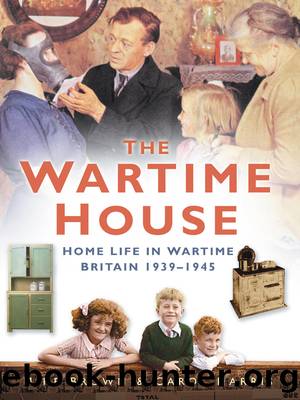The Wartime House by Mike Brown

Author:Mike Brown
Language: eng
Format: epub
ISBN: 9780752494722
Publisher: The History Press
Utility Clothing
The 1942 Civilian Clothing Order was the start of Utility clothing. The Board of Trade asked for designs for four basic outfits, and eight designers, including Digby Morten, Hardy Amies and Norman Hartnell, responded. The outfits were a top coat, a suit, an afternoon dress and a cotton overall dress. As a result, the Board of Trade had thirty-two outfits to view in September 1942. From this selection, the Board of Trade had the most suitable styles mass-produced, conforming to the regulations of the Utility scheme. These first Utility clothes were in the shops by the following spring, in 1943. Carrying the distinctive CC41 label of the scheme and made from Utility fabrics, they were a great success.
The Utility scheme was intended to ensure adequate supplies of durable good quality clothing at reasonably low prices. At the heart of the scheme was the need to save on cloth and labour, and in order to fulfil that condition all wartime clothes were made under various restrictions set out by the Making of Civilian Clothing (restrictions) Orders. For instance, in 1942 an order was made prohibiting the manufacture of menâs double-breasted coats and turned-up trousers; a limit was put on the amount of pockets and buttons; menâs shirts were to be shorter and pyjamas were to have no pockets. (This order was revoked at the end of January 1944.)
All Utility clothes, fabrics and shoes bore the official Utility mark, CC41, which stood for Civilian Clothing 1941. While they were not the only clothes available, Utility garments had one big advantage to the consumer in that maximum prices were set for all Utility cloth and garments. As the war went on, these styles made up an ever-increasing proportion of the clothes available.
UTILITY
One of the best known symbols of the Second World War was the Utility label âCC41â, which stood for Civilian Clothing 1941. It was introduced in September 1941 as part of the âLimitation of Supplies (Cloth and Apparel) Orderâ, although the scheme grew to cover far more than just clothing. The scheme was launched by Sir Laurence Watkinson of the Board of Trade. The designer Reginald Shipp was told to incorporate the double C in the logo in such a way that the public should not recognise the letters as such, and he came up with the two wedges, known at the Board of Trade as âthe cheesesâ.
The origin of the use of the word âutilityâ is hard to pin down. Its first official use seems to have been in the âUtility Cloth (Maximum Prices) Orderâ of October 1941, but it was certainly widely used before that time to denote standard or basic styles.
It is no surprise that a great deal of Utility furniture and cloth survives, some of it still in everyday use; it is a tribute to its craftsmanship. Yet it cannot be denied that for many who lived during the war, or just after it, the term âUtilityâ became synonymous with austerity, shortages and rationing. John Vaizey, in
Download
This site does not store any files on its server. We only index and link to content provided by other sites. Please contact the content providers to delete copyright contents if any and email us, we'll remove relevant links or contents immediately.
Room 212 by Kate Stewart(5016)
The Crown by Robert Lacey(4710)
Endurance: Shackleton's Incredible Voyage by Alfred Lansing(4656)
The Iron Duke by The Iron Duke(4275)
The Rape of Nanking by Iris Chang(4125)
Joan of Arc by Mary Gordon(4000)
Killing England by Bill O'Reilly(3940)
Say Nothing by Patrick Radden Keefe(3892)
I'll Give You the Sun by Jandy Nelson(3344)
Shadow of Night by Deborah Harkness(3279)
Hitler's Monsters by Eric Kurlander(3256)
Mary, Queen of Scots, and the Murder of Lord Darnley by Alison Weir(3138)
Blood and Sand by Alex Von Tunzelmann(3121)
Darkest Hour by Anthony McCarten(3058)
Eleanor & Park by Rainbow Rowell(3042)
Margaret Thatcher: The Autobiography by Thatcher Margaret(3021)
Red Famine: Stalin's War on Ukraine by Anne Applebaum(2859)
Book of Life by Deborah Harkness(2855)
The One Memory of Flora Banks by Emily Barr(2791)
